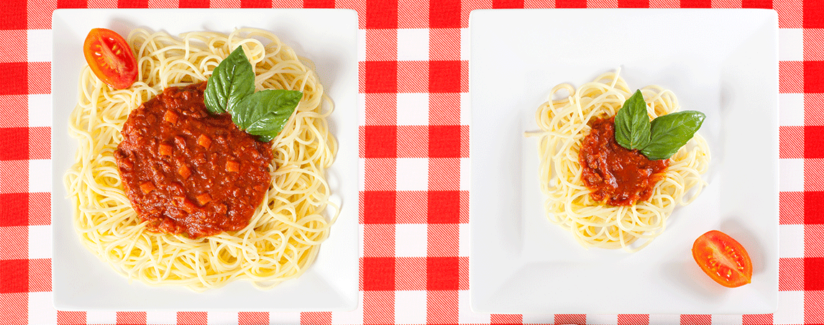
Does Portion Size Matter?
02/07/2018
Portion size – the amount of food on a plate or in a serving – impacts how much we eat. For those trying to lose weight, it is often recommended to cut down on portion size. For instance, choose a smaller plate and do not eat directly from the package to avoid overeating.
Do smaller portions, however, amount to fewer calories consumed?
Researchers at Penn State put it to the test and found some interesting conclusions. Women in the study were given meals over a period of weeks that varied in portion size. The women were divided into two sets – a control group and a group that were taught techniques to control portions and eat healthier.
Did the training make a difference? Yes, but in an unexpected way. Each of the meals contained different food options, including a higher calorie density food like garlic bread and a lower calorie density option like salad.
As the portion sizes increased, all participants ate more food, confirming previous research. However, those who had received the training ate more of the lower calorie options, such as salad, so they consumed fewer calories compared to the control group.
“The results show that choosing healthy, lower-calorie-dense foods was more effective and more sustainable than just trying to resist large portions of higher calorie options,” said Faris Zuraikat, graduate student who conducted the research. “If you choose high-calorie-dense foods but restrict the amount that you’re eating, portions will be too small, and you’re likely to get hungry.”
These observations align with insights from Best Food Facts experts on portion control and healthy eating. The Volumetrics diet is one that focuses on feeling full or utilizing the volume and calorie density of foods.
“The theory is that people tend to eat the same amount or volume of food each day, regardless of how many calories they take in. Because most of the foods in this diet are low in calorie density, by filling up on these types of foods you will be consuming fewer calories without less food,” registered dietitian Sarah Downs said.
What are those foods that are low in calorie density and promote weight loss? Fruits, vegetables and whole grains are the best bet, says Brenda Roche Wolford, M.S., R.D. of the University of California.
“Throw in some legumes (beans, peas and lentils) and you’re well on your way to a heart-healthy diet,” she said. “Fruits and vegetables also have a high water content, which helps play a role in weight control. The high water content increases the volume of what you are eating, without adding extra calories. Similar to fiber, this helps you feel fuller longer. The high water content of fruits and vegetables makes them great low-calorie options to incorporate into meals and snacks.”
Regulating portion size involves mindful eating, the practice of removing distractions and giving conscious thought to what we’re eating. Being mindful also means balancing foods for nutrition and enjoyment.
“Giving ourselves full permission to eat all foods allows us to explore our body’s cravings without guilt or judgment. Balancing the intake of foods that are both nutritious for our body and pleasurable to our body can help us engage in a meaningful, mindful eating experience that ultimately leads to a healthy relationship with food,” said Sheena Gregg, registered dietitian at the University of Alabama.
Portion size does matter and affects how much food you consume. Just cutting serving size, however, may lead to hunger and overeating later. Choosing lower calorie dense foods can help reduce overall calorie intake.




























